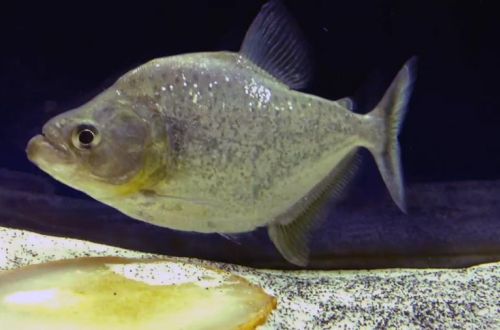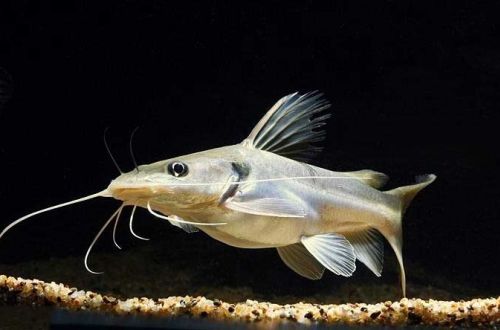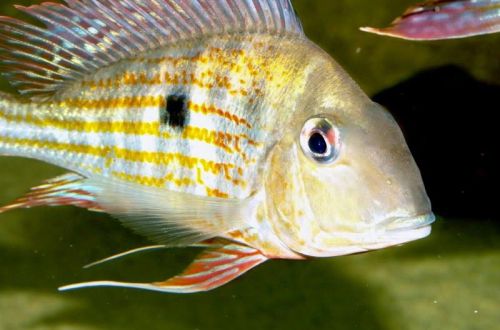
white piranha
White piranha or Brandt’s Piranha, scientific name Serrasalmus brandtii, belongs to the Serrasalmidae family. It is named after the German naturalist Johann Friedrich von Brandt (1802–1879), who first discovered and described this species. Difficult to maintain, which, however, does not stop wealthy aquarists from acquiring it. The effect that it causes compensates for the difficulties of maintenance.

Contents
Habitat
It comes from South America from Brazil. The natural habitat is limited to the basin of the Sao Francisco River, covering the eastern states of Bahia, Pernambuco, Alagoas and Sergipe. It occurs everywhere, inhabiting the main channels of rivers, floodplain lakes and reservoirs.
Brief information:
- The volume of the aquarium – from 400 liters.
- Temperature – 23-27°C
- Value pH — 5.0–8.0
- Water hardness – 3–23 dGH
- Substrate type – any
- Lighting – subdued
- Brackish water – no
- Water movement – light or moderate
- The size of the fish is about 20-25 cm.
- Nutrition – meat products
- Temperament – aggressive
- Content – Single
Description
Adult individuals reach a length of 20–25 cm. The fish has a large diamond-shaped body, squeezed from the sides. The fins are translucent with dark bases, short and shifted closer to the tail. Juveniles are silvery in color with a pattern of many dark speckles. With age, the base color becomes golden-bronze. Sexual dimorphism is weakly expressed, it is problematic to distinguish a male from a female.
Food
It is considered an omnivorous species, however, other fish are still the basis of the diet in the wild. In a home aquarium, depending on the size of piranhas, earthworms, large bloodworms, shrimp meat, mussels, and other fish are served.
Do not feed on a daily basis animal products (pork, beef) containing lipids that are difficult to digest.
Maintenance and care, arrangement of the aquarium
The optimal size of the aquarium for one fish starts from 400 liters. The choice of design doesn’t really matter. It is important to provide enough space for swimming and several places to hide, such as driftwood with thickets of plants.
When keeping the White piranha, it is important to ensure high water quality in the allowable range of temperatures and values of hydrochemical parameters. Like any carnivorous species, this fish produces a lot of waste, so a productive external filter system, regular removal of organic waste (leftover food, excrement) and weekly replacement of part of the water by 30-50% will be required. The latter, due to the large volume, can be problematic if an automatic water topping / draining system is not installed, connected to the water supply system with a water treatment system and sewerage. Without it, replacing from 200 liters every week by hand is very time consuming.
These species are rare in the hobby aquarium and quite expensive compared to other popular species. Anyone who can afford them, for sure, will equip the aquarium with everything necessary, and individual specialists can handle its maintenance. The owner can only feed his pets and admire them.
Behavior and Compatibility
In a small aquarium, and for this species 400 liters is considered a small tank, it is recommended to keep only one adult piranha. They do not favor their relatives too much and feel great alone.
The number of compatible species is very limited due to the nature of the diet. Almost any fish is at risk, except for very large or some Armored catfish, which have bony protective plates and spikes.
Breeding / breeding
There have been no successful cases of breeding Piranha Brandt in the home aquarium. In nature, the reproductive cycle lasts all year. With the onset of favorable conditions, usually the rainy season, spawning occurs.
Fish diseases
It is an unpretentious and hardy fish. Health problems are associated with injuries, poor nutrition and inappropriate water composition. In the event of the appearance of signs of illness (lethargy, change in body shape, loss of appetite, etc.), it is sometimes enough to bring the conditions of detention back to normal so that the body copes with the problem. However, in some cases, medical treatment will have to be used. Read more about symptoms and treatments in the Aquarium Fish Diseases section.





